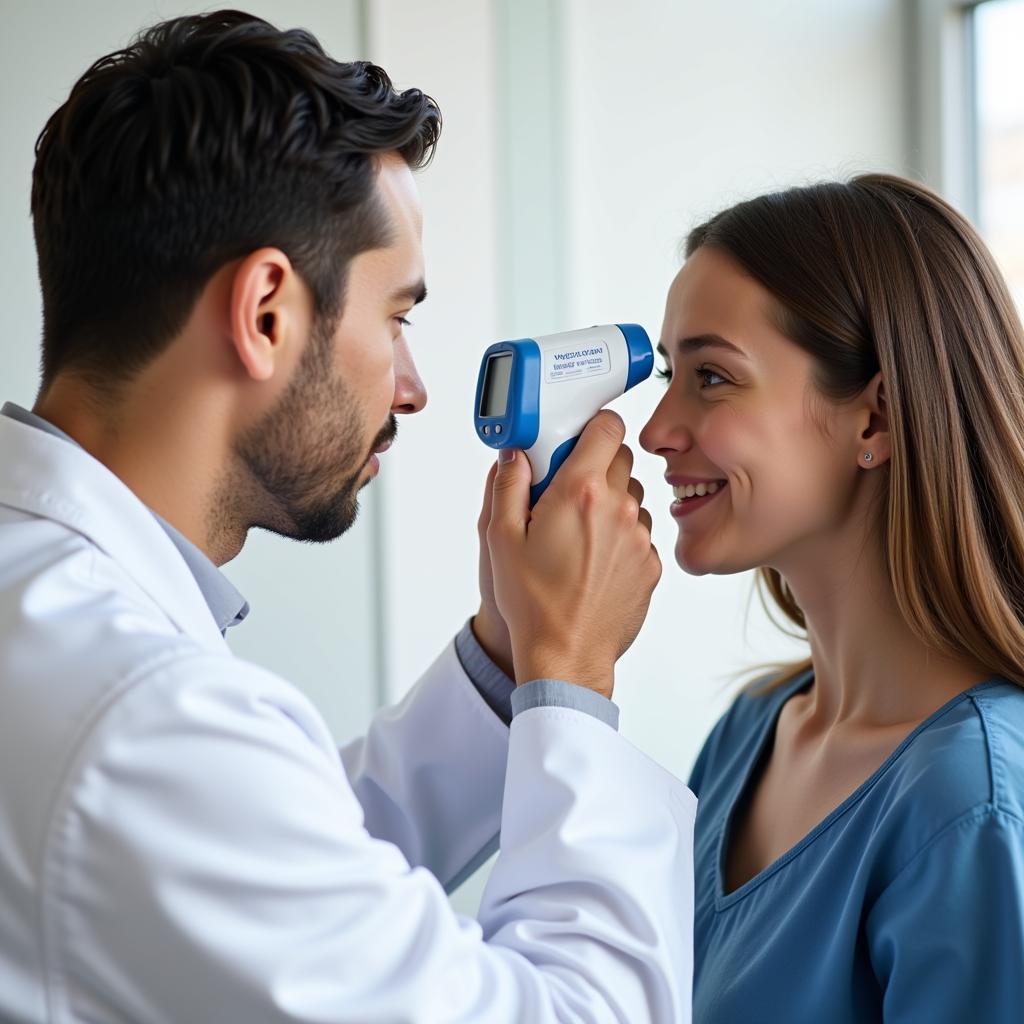Thermometers for hospitals are crucial tools for accurate temperature measurement, playing a vital role in patient care and diagnosis. From traditional mercury thermometers to advanced digital infrared devices, understanding the various types, their applications, and best practices is essential for any healthcare professional. This guide will delve into the world of hospital thermometers, providing valuable insights into their selection, use, and maintenance. After reading this guide, you’ll have a comprehensive understanding of this vital piece of medical equipment.
Types of Thermometers for Hospitals
Several types of thermometers are commonly used in hospitals, each with its own advantages and disadvantages. Choosing the right thermometer depends on the specific application, patient population, and hospital guidelines. Let’s explore some of the most prevalent types:
- Digital Thermometers: These thermometers provide quick and accurate readings, utilizing electronic sensors to measure temperature. They are commonly used for oral, axillary, and rectal temperature measurements.
- Infrared Thermometers: Offering non-contact temperature measurement, infrared thermometers are ideal for quick screenings and minimizing the risk of cross-contamination. They measure the infrared energy emitted from the body.
- Tympanic Thermometers: Designed for measuring ear temperature, tympanic thermometers are fast and convenient, especially for children. However, they require proper technique to ensure accurate readings.
- Temporal Artery Thermometers: These thermometers scan the forehead to measure the temperature of the temporal artery. They offer a non-invasive and comfortable method, particularly suitable for infants and young children.
Choosing a hospital grade thermometer is crucial for ensuring accurate readings and infection control.
 Digital Thermometer Used in a Hospital Setting
Digital Thermometer Used in a Hospital Setting
Accuracy and Calibration of Hospital Thermometers
Maintaining the accuracy of thermometers for hospitals is paramount for effective patient care. Regular calibration and proper usage techniques are essential. Here’s what you need to know:
- Calibration: Thermometers should be calibrated regularly according to manufacturer recommendations and hospital protocols. This ensures that the readings are accurate and reliable.
- Proper Technique: Using the correct technique for each type of thermometer is crucial for obtaining accurate measurements. For example, when using a digital thermometer orally, it should be placed under the tongue and held in place until a reading is obtained.
- Hygiene and Infection Control: Cleaning and disinfecting thermometers between patients is essential to prevent the spread of infection. Following hospital guidelines for infection control is paramount.
For emergency animal care, consider resources like animal emergency & trauma hospital wilmington nc.
 Nurse Calibrating a Medical Thermometer in a Hospital Lab
Nurse Calibrating a Medical Thermometer in a Hospital Lab
Understanding Temperature Readings and Interpretation
Interpreting temperature readings correctly is crucial for appropriate diagnosis and treatment. Here’s a quick guide to understanding normal and abnormal temperature ranges:
- Normal Body Temperature: The average normal body temperature is 98.6°F (37°C). However, individual variations can occur.
- Fever: A fever is generally considered a temperature of 100.4°F (38°C) or higher.
- Hypothermia: Hypothermia occurs when the body temperature drops below 95°F (35°C).
Knowing what constitutes a normal temperature range helps healthcare professionals identify potential health concerns. You can also find emergency animal services at locations like dundee animal hospital emergency.
 Doctor Checking a Patient's Temperature with a Thermometer
Doctor Checking a Patient's Temperature with a Thermometer
Best Practices for Using Thermometers in Hospitals
Implementing best practices for using thermometers for hospitals contributes to accurate measurements and infection control. Here are some key recommendations:
- Follow Manufacturer Instructions: Always consult the manufacturer’s instructions for specific usage and cleaning guidelines for each type of thermometer.
- Adhere to Hospital Protocols: Hospitals have specific protocols for using and maintaining thermometers. Adhering to these guidelines is crucial for ensuring patient safety.
- Document Temperature Readings: Accurate documentation of temperature readings is essential for tracking patient progress and informing treatment decisions.
Another option for 24-hour animal care is animal hospital louisville ky 24 hour. Accurate temperature readings are crucial in both human and animal healthcare.
In conclusion, thermometers for hospitals are indispensable tools for patient care. Understanding the different types, their applications, and best practices is vital for healthcare professionals. By adhering to proper usage, calibration, and infection control procedures, hospitals can ensure accurate temperature measurement and contribute to positive patient outcomes. Remember to always consult manufacturer guidelines and follow hospital protocols for optimal results when using thermometers for hospitals.
FAQ:
- What is the most accurate type of Thermometer For Hospital use?
- How often should hospital thermometers be calibrated?
- What are the proper cleaning techniques for hospital thermometers?
- How do I interpret different temperature readings?
- What are the symptoms of a fever?
- What are the signs of hypothermia?
- Where can I find more information on infection control practices for thermometers?
Need further assistance? Consider looking into 24 hour animal hospital rockford il. For any inquiries regarding our services or to schedule an appointment, please contact us. Call us at: 02437655121, Email: [email protected] or visit us at: 298 Cau Dien St., Minh Khai Ward, Bac Tu Liem Dist., Hanoi, Vietnam. We have a 24/7 customer service team available.